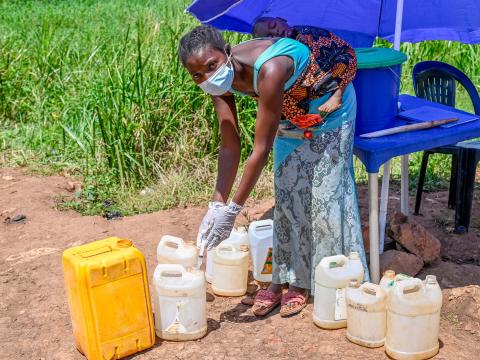DR Congo: From Crisis to Resilience – Our Response to the Cholera Outbreak in Likasi

By Tatiana Ballay, Communication Officer
In January 2025, the city of Likasi, a strategic mining hub in the Haut-Katanga province, was hit by a severe cholera outbreak. The first cases emerged in the neighborhoods of Kanona (Kikula Health Zone) and Simba (Likasi Health Zone), two densely populated areas with limited access to safe drinking water, poor sanitation conditions, and widespread lack of knowledge about basic hygiene practices. The rapid spread of the cholera bacterium affected several of World Vision's program areas, including Kikula with 626 confirmed cases and 30 deaths, Simba with 88 cases, as well as Kisunka and Fungurume. In this context, World Vision positioned itself as a key player alongside the Ministry of Health and other partners to protect vulnerable children and families by launching its cholera response.
A Rapid Response to Failing WASH Infrastructure
The mobilization effort, which involved 142 community health workers (RECO) and religious leaders, reached 54,528 people through door-to-door campaigns and sessions held in schools, churches, and markets. These sessions focused on the five critical moments for handwashing, water purification methods, and early recognition of symptoms. In Simba, World Vision sensitized 18,758 individuals (16,626 adults, including 8,773 women; 2,132 children, including 1,191 girls), among them 62 sponsored children (38 girls). In addition, 36 teachers were trained to relay hygiene messages in schools.
"Thanks to World Vision’s support, we were able to closely monitor recovered cases in the community to prevent relapses and reinforce the adoption of good hygiene practices," said Emmanuel Kipanga, Supervisor of the Likasi Health Zone.
This mobilization was supported by targeted disinfection sessions and intensive sanitation. In Kikula, for instance, 254 homes of confirmed cases and 5,080 contact households were disinfected. In Simba, 1,848 households received the same intervention, while in Fungurume, more than 7,000 households were treated. To support these efforts, World Vision provided 100 kg of granular chlorine and appropriate buckets.
"World Vision’s support enhanced our response capacity on the ground. The strong involvement of community health workers played a crucial role in monitoring and gradually controlling the outbreak," said Dr. Blaise Musoya Mumba, Chief Medical Officer of the Kikula Health Zone.
The response also covered other program areas, saving lives.
"World Vision’s assistance was a key lever in our response. Access to chlorinated water and the equipment provided helped with patient care and in bringing the situation under control in Fungurume," explained Dr. Jacques Mukembe, Chief Medical Officer of the Fungurume Health Zone.
Looking Ahead
The response was strengthened by close coordination among several key players: the Ministry of Health, which officially declared the epidemic and led overall coordination; UNICEF, which provided essential support in water chlorination and WASH interventions; WHO, which managed epidemiological monitoring; as well as various local NGOs and grassroots communities involved in community-level response efforts.
World Vision’s contribution enabled the affected health zones to bring an epidemic under control that had threatened more than 500,000 people. It helped save hundreds of lives through prevention, sanitation, and rapid care actions, while sustainably strengthening local capacities through ongoing training of community health workers (RECO), mass awareness campaigns, and the installation of chlorinated water infrastructure.
"Awareness is paying off: families now know how to protect themselves, and children have become hygiene ambassadors in their communities," shared Minos, a RECO representative from the Petwe Health Area.
Vigilance remains essential.